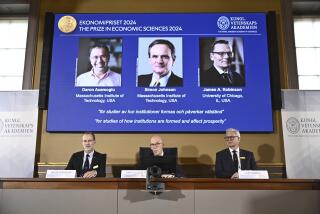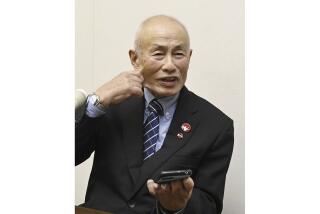A Nobel Prize for Creativity
The University of Chicago lays claim to an astonishing 78 Nobel laureates -- the most of any institution in the United States and second in the world only to England’s University of Cambridge.
Renowned physicists Hans Bethe and Werner Heisenberg and economics guru Paul A. Samuelson are all counted among Chicago’s Nobel brethren.
Wait a minute.
Didn’t Bethe spend virtually his entire career at Cornell University? Isn’t Samuelson considered the heart and soul of MIT economics? Did Heisenberg even spend more than a few months in Chicago?
“I think the University of Chicago counts everyone who ever walked through there,” said Herbert Kroemer, a UC Santa Barbara professor who shared the Nobel Prize for physics in 2000.
Counting Nobel Prizes is the ultimate academic sport. It is a no-holds-barred exercise in selective memory and fuzzy math.
Universities that normally pride themselves on academic virtues and scholastic precision can find themselves grasping for any plausible thread of affiliation with those anointed by Stockholm.
The University of Cambridge in Britain touts philosopher Bertrand Russell as its first Nobel laureate in literature, yet conveniently fails to mention that the 1950 prizewinner was fired for his antiwar activities during World War I.
During the Depression, Johns Hopkins and Columbia universities refused to give Maria Goeppert Mayer a real job with pay (she did research as a volunteer while her husband was a professor), but both were eager to claim credit for her 1963 Nobel Prize in physics.
The University of Chicago is widely viewed as having the most expansive method of counting Nobel laureates.
“There are some people on our list who were here only for a few years,” acknowledged Larry Arbeiter, who tracks the prizes for the university. “I have often wondered: ‘Is that the appropriate way to do that? Is there a better way to do it?’ I haven’t been able to come up with one.”
Some schools have resisted the temptation to go Nobel-scrounging, using the strict criterion of only claiming laureates currently on their campuses.
“Some of them are really quite restrained,” said sociologist Harriet Zuckerman, author of “Scientific Elite: Nobel Laureates in the U.S.”
“But not many.”
*
Since the first gold medals were handed out in 1901, Swedish dignitaries have awarded 780 Nobel Prizes for achievements in physics, chemistry, physiology or medicine, economics, literature and peace. (The Nobel Memorial Prize in Economic Sciences is to be announced today; a date for this year’s literature announcement has not yet been set.)
However, the total number of prizes claimed by universities reaches into the thousands.
Swedish industrialist Alfred Nobel, who made his fortune from the invention and manufacture of dynamite, might take some pride in the extent to which the claiming of his awards have become an intercollegiate sport.
He set forth in his will that his fortune be used to endow “prizes to those who, during the preceding year, shall have conferred the greatest benefit on mankind.”
Each prize -- often split two or three ways -- includes a substantial cash award meant to give winners the financial freedom to focus entirely on their research. This year’s award is $1.3 million.
In the early 1900s, most winners hailed from Europe. The first crop included German physicist Wilhelm Conrad Roentgen for his discovery of X-rays and Swiss philanthropist Jean Henry Dunant, who inspired the Geneva Convention and founded the Red Cross.
After World War II, the American scientific and technical juggernaut that propelled the country to superpower status came to dominate the Nobels.
Predictably, competitive tallies soon followed.
“Although such competition seems trivial, it is serious business,” Zuckerman wrote in “Scientific Elite.”
Nobel Prizes make schools attractive to prospective students, faculty and donors, conferring the aura of a winner. A university’s roster of laureates is “probably more significant than [the college rankings in] U.S. News and World Report,” said F. Sherwood Rowland, a UC Irvine professor who won the Nobel Prize for chemistry in 1995.
UCLA’s two consecutive Nobels in chemistry and medicine in the 1990s clearly boosted the Westwood campus’ standing. “It meant a lot to UCLA,” said Paul Boyer, a professor emeritus who won the chemistry prize in 1997.
The problem is that some universities can’t help engaging in a little Nobel Prize inflation.
There is good reason for ambiguity in the accounting.
“A university does many things,” said David J. Gross, a UC Santa Barbara professor who won the Nobel Prize for physics in 2004. “It teaches, so it’s proud of its students who went on to do good things. They’re proud of their researchers who worked at the institution who have done good things. And of course they’re proud of the people who are there now and their impact on current research and current teaching.”
So one school might claim a Nobel laureate who was there as an undergraduate, another for graduate work, another for advanced research, and several for being on the faculty. Who can say which school is most worthy?
Caltech President David Baltimore, whose 1975 Nobel Prize for physiology or medicine is claimed by MIT, Rockefeller University and Caltech, sees no need to attempt an answer.
“It is sort of a game, and you might as well play it by whatever rules you want, like solitaire,” he said.
Caltech, which touts 31 “recognized heroes” who have garnered 32 Nobel Prizes over the years (Linus Pauling won for both chemistry and peace), gives itself credit for laureates among faculty and alumni. Former staffers may also be counted if they did some of their prize-winning work at the Pasadena campus.
Visiting professors are out of bounds, Baltimore said.
Among the strictest counters is UC Santa Barbara.
The official tally includes only the five professors who won Nobels while at UCSB, all of whom are still active members of the faculty.
“It’s logical,” said Chancellor Henry T. Yang. Counting any other way “has never occurred to me.”
Although UCSB is still trying to repair the academic damage after being named Playboy magazine’s No. 22 party school in 2002, they have won so many Nobels recently that they can afford to be strict.
“You don’t just lie down on the beach and win Nobel Prizes,” Yang said.
UCSB even declined to claim 2004 physics Nobelist Frank Wilczek of MIT and three other laureates who spent time on campus but are no longer at the school.
“I’m disappointed,” Wilczek said. “I spent several years there. I was one of the founding members of their Institute for Theoretical Physics. I would have thought they’d be proud to claim me.”
The University of Chicago, however, was happy to claim Wilczek by virtue of his 1970 bachelor’s degree in mathematics.
Chicago counts anyone who has studied or worked there full time, including professors with temporary appointments and research associates who worked on campus as part of World War II’s Manhattan Project to build the atomic bomb.
On the official list of laureates is 1958 physiology/medicine winner Sir John Carew Eccles, who was a “professorial lecturer” in the physiology department in 1966, and 1939 physics Nobelist Ernest Orlando Lawrence, who spent only one year on campus as a graduate student before receiving his Doctorate from Yale University. (Chicago granted him an honorary degree in 1941.)
What puzzles so many critics of the University of Chicago’s liberal Nobel accounting system is the fact that the venerable institution feels it is necessary in the first place.
Wilczek, who is proud to be listed on Chicago’s Nobel honor roll, scoffs at the school’s practice of taking credit for prizes awarded to visiting faculty members.
“That’s pretty lame,” he said. “Chicago has a lot to be proud of, but maybe it ... makes them seem ridiculous to stretch it that much.”
Still, he understands the motivation. “They feel they’re in competition with the Ivy Leagues,” he said. “They’re kind of isolated in the Midwest.”
Arbeiter, the University of Chicago official, says it’s far from clear how to formulate a rule that would be fair in all cases.
“What would be the strictest criteria -- that you can’t claim a prize unless he or she was educated there, spent time there, did the work there, was there when they won and is there still?” he said. “There may be two people who fit that criteria in the history of the Nobel.”
One person who comes close is economist Robert M. Solow, who won the Nobel in 1987. After getting his Doctorate at Harvard, he accepted a position as assistant professor at MIT but first spent a year at Columbia to beef up on statistics. He arrived at MIT in 1950 and stayed for 45 years.
Yet Columbia includes Solow on its list of laureates, describing him as a member of the faculty for one year. Its liberal counting method nets 72 laureates, the second-highest total in the country behind the University of Chicago.
The Nobel shenanigans have prompted Stanford economist Kenneth J. Arrow to devise a mathematical formula for tallying Nobel credit.
“Count the fraction of time in your academic career until retirement that you were at that institution” and give each school a corresponding percentage of the credit, he said.
Arrow came up with his system after he won the Nobel for economics in 1972 while a professor at Harvard University. Harvard took credit for the win even though none of his prize-winning research was done there.
Using his formula, Stanford would get about 60% of the glory. Harvard would be entitled to 20% of the bragging rights, but no bonus for having him on its faculty at the time of the award.
Baltimore of Caltech scoffs at such easy dismissal of extra credit points for the home team.
“We’re happy for people to get the prize, and we’re particularly happy when they’re on campus because we can have a party,” he said.
*
(BEGIN TEXT OF INFOBOX)
Nobel inflation
Many universities are quick to claim Nobel laureates as their own, even if the laureates’ association with the institution was fleeting.
The universities claiming the largest number of Nobel Prizes*
1. Cambridge University, England: 81
2. University of Chicago: 78
3. Columbia University: 73
4. MIT: 60
5. Oxford University, England: 47
6. Harvard University: 42
7. Caltech: 32
8. Johns Hopkins University: 31
9. Cornell University: 30
10. Princeton: 29
*As of Oct. 9. Different universities often claim the same laureates.
Source: Times research
More to Read
Sign up for Essential California
The most important California stories and recommendations in your inbox every morning.
You may occasionally receive promotional content from the Los Angeles Times.











